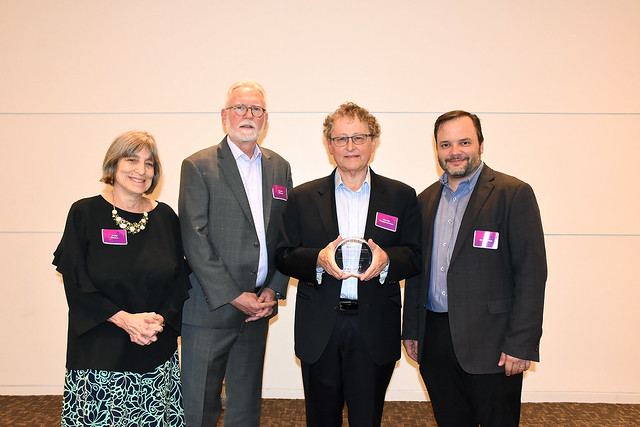Lax Lecture Highlights the Latest Advancements in HIV Research
“Hope is a state of mind, not a state of the world. Either we have hope within us or we don’t; it is a dimension of the soul not essentially dependent on some particular observation of the world or estimate of the situation. It is an orientation of the spirit, an orientation of the heart […] Hope is an ability to work for something because it is good, not just because it stands a chance to succeed. The more unpropitious the situation in which we demonstrate hope, the deeper the hope is.”
This quote by Czech statesman and writer Václav Havel was posted on the fridge in the home of Jonathan Lax, one of the most transformative AIDS activists in Philadelphia. Lax volunteered his time to provide medical care through drug access to treatments not available in the U.S., and helped many young, HIV-positive men connect with doctors to find medical help.
After his passing in 1996, The Wistar Institute, Philadelphia FIGHT and other scientific and community partners came together and established the Annual Jonathan Lax Memorial Lecture to honor his memory and create a direct channel of communication between the scientific process of studying HIV and the community it serves.
The Lecture has reached its 24th year, fittingly celebrated on Monday, June 24.
“Every year, this event carries forward our mission of making HIV science accessible to everyone, while researching better therapies for HIV,” said Luis J. Montaner, D.V.M., D.Phil., Herbert Kean, M.D., Family Professor and director of the HIV-1 Immunopathogenesis Laboratory at Wistar, and one of the founders of the Lax Memorial Lecture.
During the opening remarks, Jane Shull, executive director of Philadelphia FIGHT, commented that in the early days of the HIV epidemic, ordinary people had to stand up in the face of silence from government institutions and lack of resources to tackle AIDS. It was a growing public health emergency and people took it into their own hands to stop the epidemic.
“Although he was a rather extraordinary person, Jon was one of these ordinary people that made a difference,” said Shull. “Those activists won their battle and we are all the better for that.”
“We must remember the days when the barrier between science and the community came down,” added Shull. “This Lecture keeps that spirit going.”
Montaner remarked on how this event is meant to be an opportunity for the local community to be exposed to new trajectories of research and remain abreast of scientific advances in the HIV field.
The audience, including community members, HIV advocates and researchers, heard from Michel C. Nussenzweig, M.D., Ph.D., Zanvil A. Cohn and Ralph M. Steinman Professor at The Rockefeller University and Howard Hughes Medical Institute investigator, who studies the immune response to HIV infection with particular focus on antibodies and is advancing promising novel approaches.
Nussenzweig discussed the characteristics of HIV infection that make the immune response to this virus atypical compared with other infectious agents. In fact, only a small fraction of HIV-infected individuals develops effective antibodies, known as broadly neutralizing antibodies (bNAbs), able to neutralize the majority of circulating HIV virus variants. In addition, it takes their immune system a very long time — two to three years — to do so.
Only five of these antibodies were isolated between 1981 and 2009, and these were not very potent, reported Nussenzweig. This aspect, and the fact that HIV can shield itself with host-derived molecules to go undetected by the immune system, have made the process of developing an effective HIV vaccine extremely challenging.
His and other laboratories have recently developed more effective methods to isolate bNAbs from HIV-positive individuals.
“By looking to the people that develop bNAbs, we gain information that can assist us in designing future vaccines,” said Nussenzweig. “We also asked, what can we do with these potent antibodies for therapy and prevention?”
Therefore, they tested the possibility of passive immunization with bNAbs in animal models. These studies showed that bNAbs are able to suppress viremia, or presence of the virus in the blood, and preserve the host T cells, giving the immune system time to build a good response to the virus.
Based on these encouraging results, this approach has been moved to clinical testing. More than 200 people have been involved so far, confirming that bNAbs are very safe and can delay viremia rebounding in individuals that discontinue antiretroviral therapy (ART).
In particular, Nussenzweig and his collaborators tested in nine individuals a combination of two broadly neutralizing antibodies called 3BNC117 and 10-1074, which bind different portions of the HIV virus. All nine maintained long-term viral suppression in the absence of ART and none developed resistant viruses.
Nussenzweig said he is very optimistic that passive administration of potent bNAbs represents a potential alternative to ART therapy. “Not only can bNAbs neutralize the virus, they also engage the host immune system, something that ART cannot do.”
Answering a question from the audience regarding the cost of this approach, he said that it would be acceptable and believes that “bNAbs could be produced with acceptable costs and would be broadly available to the HIV community, including in developing countries.”
In this day and age in the fight against HIV, what we hope for and how far scientists have come are getting closer and closer.

